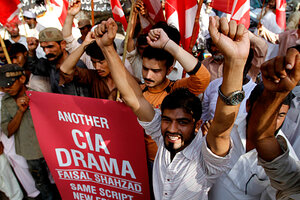Faisal Shahzad case intensifies scrutiny of links between Pakistan militant groups
Officials aren't saying which militants, if any, Faisal Shahzad may have met in Pakistan, but focus is intensifying on how interlinked Pakistan militants groups may be. Pakistan and US officials differ in their assessments.

Supporters of the youth wing of Pakistani religious party Jamat-e-Islami rally to support the New York City's Times Square bombing suspect Faisal Shahzad in Karachi, Pakistan Thursday.
Shakil Adil/AP
New Delhi
How connected are the slew of militants groups inside Pakistan? That question is poised to shape Washington's demands and Islamabad's response to the Times Square bomb plot once the investigation finishes.
Already, some US officials appear to be shaping the debate by emphasizing the idea that these groups are interlinked. That formulation would put pressure on Islamabad to move not just against any one or two groups found to have helped Faisal Shahzad, but against the entire constellation of jihadi organizations in Pakistan.
Pakistan's security establishment, however, has differentiated between these militant groups in its engagements. Some factions are doggedly pursued; others are left alone, trusted with truces, or clandestinely encouraged. Such an approach assumes the groups are more independent than intertwined.
That's how retired Pakistani generals who have been down in the pit snake-handling these groups still portray the situation today. But younger researchers argue that, increasingly, the connections are growing.
"It doesn't mean there aren't varying degrees of hierarchy, command-and-control, and distinctions between these guys. But they are all more interconnected than they were in the past," says Stephen Tankel, a visiting scholar at the Carnegie Endowment for International Peace.
Investigators are not saying officially which militants, if any, Mr. Shahzad may have met with in Pakistan. Jaish-e-Mohammad and Lashkar-e-Taiba (LeT), two groups originally focused on the Kashmir conflict, and the Tehrik-e Taliban Pakistan (TTP) have all been mentioned by unnamed sources in media reports. Doubt that Shahzad met with anyone – or at least anyone he is rattling off – are also surfacing in reports.
If Shahzad indeed bounced around Pakistan's militant underworld of handlers, trainers, and financiers, getting fixated on which group "deployed" him back to the US may ignore the danger posed by the loose system of affiliation and cooperation.
"Whether or not LeT is going to deploy its own operatives to attack America tomorrow, it's still a threat to the West because it's still a gateway to other organizations, and it will still provide training to people who wish to do the West harm," says Mr. Tankel. "To say only the guys who sent [Shahzad] back out are the threat is wrong. It's also the guys who received him."
Militants move between groups
Manzar Zaidi, the director of research and analysis at the National Counterterrorism Authority, a new government body in Islamabad, says militants move between groups, break away, and start new ones regularly. Sometimes commanders jump, bringing the fighters under them along. Splinters and spin offs emerge after leadership disputes or government crackdowns. Individual veterans from the Afghan wars drift in and out of groups.
"It's not uncommon for one person to have been a member of four or five groups over time," says Mr. Zaidi. "These organizations are very flexible, mobile, fluid."
The cross-pollination makes it easier for veterans to vouch for newbies and direct them to multiple organizations. It also increases the ability of people with rare skills in things like bomb-making to make the rounds, spreading the training.
"Unless there's a crackdown on every militant group, the situation will not become pacified. All these groups, they tend to start cooperating, even if not on an ideological level. They tend to interact with other groups," says Zaidi.
Ideological outlook key
What's going on at the ideological level very much matters for Hamid Gul, a retired military general and former director of Pakistan's Inter-Services Intelligence agency. He divides the groups into three distinct and independent categories based on their geographic focus.First there are the Afghan Taliban, who are fighting a jihad against US occupation of Afghanistan. "They are not inimical to the interests of Pakistan," he says.
In a second category he places the militant groups formed to fight in Kashmir. He says that while some members of these groups have been found in the Waziristan tribal area, he sees little proof of a deep connection between the Kashmir groups and those in the third category: militants fighting against Pakistan.
"The groups in the tribal areas are absolutely different than what we have in other parts of Pakistan," says (ret.) Gen. Mahmood Shah, a former governor of Pakistan's tribal areas. "I think they maintain independence with each other."
The only group from outside the tribal area with significant links to the Taliban, he says, is Lashkar-i Jangvi, an anti-Shiite terror group.
However, he agrees that there are militants who have broken ranks with Kashmir-focused groups and migrated to the tribal areas to join the Taliban. Many of these have become known as the Punjabi Taliban and fall under the TTP umbrella.
He says that the US would probably like to put all these groups in one basket, pressuring Pakistan to move into North Waziristan, a haven for Afghan Taliban, retreating TTP leaders, and the Punjabi Taliban.
"Pakistan cannot open many fronts at one time. It is proceeding along a plan against [all these] elements, and I am sure they will continue doing that," says Mr. Shah.
Zaidi warns against complacency when it comes to militant groups who appear manageable or focused on next-door conflicts in Kashmir and Afghans.
"It's been documented that even so called 'pliant groups' – even LeT – they have had people moving in and out or staying as guests who had more internationalist linkages," says Zaidi. "At this point, it's too late to say that we have to separate better groups, tame ones, from uncontrollable ones."
Related:
